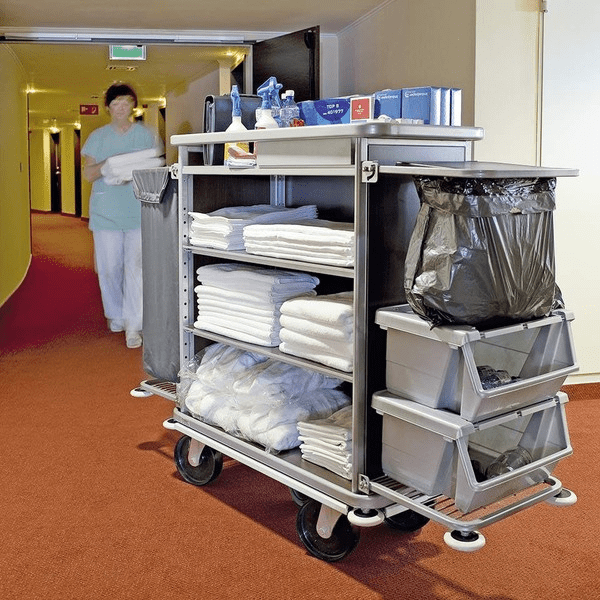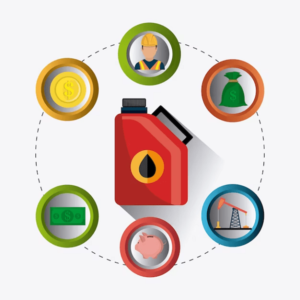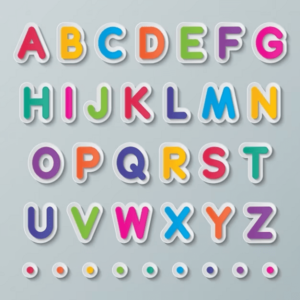Maid’s cart- A maid’s cart, often referred to as a housekeeping or cleaning cart, is a mobile cart or trolley used by hotel maids, janitors, or professional cleaners to transport cleaning supplies, tools, and linens while performing cleaning tasks. These carts are designed to be convenient and efficient, allowing cleaning staff to have easy access to everything they need to clean and maintain the designated area. Common features of a maid’s cart typically include:
- Shelves and Compartments: The cart is equipped with shelves, drawers, and compartments for organizing and storing cleaning supplies, towels, linens, and other materials.
- Trash and Linen Bags: It often has space for trash bags and laundry bags to collect waste and used linens.
- Mop and Broom Holders: Special slots or clips to securely hold mops, brooms, and other cleaning tools.
- Buckets and Pails: Some carts have built-in buckets or pails for mixing cleaning solutions or carrying water.
- Paper Towel and Tissue Holders: Dispensers for paper towels, tissues, and toilet paper.
- Cleaning Chemical Storage: A dedicated area for storing cleaning chemicals, often with locks or secure latches to prevent access by unauthorized personnel.
- Wheels and Casters: Maid’s carts are mounted on wheels or casters, making it easy to move them around a facility.
- Handles: Handles for pushing or pulling the cart, with ergonomic design for user comfort.
- Signage and Labels: Some carts have signs or labels for instructions or identification.
- Housekeeping Supplies: Maid’s carts may come with additional items such as vacuum cleaners, irons, ironing boards, and other supplies needed for cleaning and maintaining rooms in a hotel or other facilities.
Maid’s carts play a crucial role in ensuring efficient and effective cleaning and maintenance of various spaces, including hotel rooms, office buildings, hospitals, and more. They help cleaning staff complete their tasks in a systematic and organized manner, ensuring that all necessary supplies are readily available as they move from one area to another.
What is Maid’s cart
A maid’s cart, often referred to as a housekeeping or cleaning cart, is a mobile cart or trolley used by maids, housekeepers, or professional cleaners in various settings, such as hotels, resorts, hospitals, offices, and other commercial or residential spaces. These carts are designed to facilitate the cleaning and maintenance of rooms and common areas by providing a convenient and organized way to transport cleaning supplies, tools, and linens.
The features of a maid’s cart typically include:
- Shelves and Compartments: These carts come equipped with multiple shelves, drawers, and compartments to store and organize cleaning supplies, towels, linens, and other items needed for cleaning and maintaining rooms.
- Trash and Linen Bags: There is usually space on the cart to hold trash bags for collecting waste and laundry bags for used linens.
- Mop and Broom Holders: Special slots or clips are provided to securely hold mops, brooms, vacuum cleaners, and other cleaning tools.
- Buckets and Pails: Some carts have built-in buckets or pails for mixing cleaning solutions or carrying water for cleaning tasks.
- Paper Towel and Tissue Holders: Dispensers for paper towels, tissues, and toilet paper are often included for quick access.
- Cleaning Chemical Storage: Maid’s carts typically have a dedicated area for storing cleaning chemicals, often with locks or secure latches to prevent unauthorized access.
- Wheels and Casters: These carts are mounted on wheels or casters, allowing easy mobility and maneuverability.
- Handles: Maid’s carts come with handles that make it easy for cleaning staff to push or pull the cart as they move from one area to another.
- Signage and Labels: Some carts may have signs or labels for instructions, identification, or safety information.
Maid’s carts are essential tools for cleaning and housekeeping professionals, enabling them to efficiently perform their tasks and maintain a high level of cleanliness and organization within the spaces they are responsible for. These carts are particularly common in the hospitality industry, where they are used in hotels and resorts to clean and prepare guest rooms. However, they are also used in various other settings where cleaning and maintenance are required.
Who is Required Maid’s cart
Maid’s carts are typically required by housekeeping and cleaning staff in various industries and settings, including:
- Hotels and Resorts: Maid’s carts are commonly used by hotel and resort housekeeping staff to efficiently clean and maintain guest rooms. They carry cleaning supplies, linens, toiletries, and other items needed to prepare rooms for incoming guests and keep them clean during their stay.
- Hospitals and Healthcare Facilities: In healthcare settings, maid’s carts are used to transport cleaning supplies, disinfectants, and linens for cleaning patient rooms, common areas, and healthcare facilities. They play a crucial role in maintaining hygiene and infection control.
- Office Buildings: Cleaning crews in office buildings use maid’s carts to clean and maintain office spaces, restrooms, and common areas. These carts are essential for keeping the workplace clean and presentable.
- Residential Cleaning Services: Maid’s carts are used by professional residential cleaning services and individual housekeepers to transport cleaning supplies and equipment when cleaning homes and apartments.
- Educational Institutions: Schools, colleges, and universities may employ cleaning staff who use maid’s carts to maintain cleanliness in classrooms, dormitories, and other areas.
- Commercial and Retail Spaces: Cleaning personnel in commercial and retail settings use maid’s carts to clean and organize the premises. These carts help ensure a clean and welcoming environment for customers.
- Industrial and Manufacturing Facilities: In large industrial or manufacturing facilities, maid’s carts may be used to transport cleaning supplies and equipment for maintaining cleanliness and safety in work areas.
- Cruise Ships: Cruise ship housekeeping staff use these carts to clean and maintain passenger cabins and common areas on the ship.
- Airports: Airport janitorial and cleaning crews may use maid’s carts to keep terminals, restrooms, and other areas clean and tidy.
Maid’s carts are an essential tool for maintaining cleanliness and hygiene in various environments. They provide a mobile and organized solution for cleaning staff to carry out their tasks efficiently and effectively. The specific requirements for maid’s carts may vary depending on the industry and the cleaning needs of the particular setting.
When is Required Maid’s cart

Maid’s carts are required or used in various situations and scenarios where cleaning and housekeeping tasks need to be performed. They are typically used in the following situations:
- Hotel and Hospitality Industry: Maid’s carts are a common sight in hotels and resorts. They are used daily to clean and prepare guest rooms. Housekeeping staff use these carts to carry cleaning supplies, fresh linens, towels, and amenities to ensure that guest rooms are clean and well-stocked.
- Healthcare Facilities: In hospitals, nursing homes, and other healthcare settings, maid’s carts are used to clean and maintain patient rooms, common areas, and medical facilities. These carts are essential for infection control and maintaining hygiene.
- Office Buildings: Commercial cleaning crews use maid’s carts to clean and maintain office spaces, restrooms, and common areas in office buildings. Regular cleaning helps create a clean and professional work environment.
- Residential Cleaning Services: Individual housekeepers and professional residential cleaning services use maid’s carts when cleaning homes and apartments for clients. These carts help organize and transport cleaning supplies.
- Educational Institutions: Schools, colleges, and universities employ cleaning staff who use maid’s carts to maintain cleanliness in classrooms, dormitories, cafeterias, and other areas on campus.
- Retail and Commercial Spaces: Cleaning personnel in retail stores, shopping malls, and commercial spaces use maid’s carts to keep the premises clean and well-maintained. This is essential for customer satisfaction and safety.
- Industrial and Manufacturing Facilities: Large industrial or manufacturing facilities may use maid’s carts to transport cleaning supplies and equipment for maintaining cleanliness, safety, and compliance with regulations.
- Cruise Ships: Housekeeping staff on cruise ships use maid’s carts to clean and maintain passenger cabins, public areas, and recreational spaces.
- Airports: Janitorial and cleaning crews at airports use maid’s carts to ensure the cleanliness and sanitation of terminals, restrooms, and other areas within the airport.
Maid’s carts are employed in these and various other settings where cleanliness and hygiene are crucial. They provide an organized and efficient way for cleaning staff to move from one area to another while carrying all the necessary supplies and tools needed for their tasks. The specific requirements and use of maid’s carts may vary depending on the industry and the unique cleaning needs of each environment.
Where is Required Maid’s cart
Maid’s carts are typically required and used in various locations and settings where cleaning and housekeeping tasks are necessary. They can be found in the following places:
- Hotels and Resorts: Maid’s carts are a common sight in the hospitality industry, specifically in hotels and resorts. They are used to clean and maintain guest rooms, ensuring that they are clean and well-stocked with amenities.
- Healthcare Facilities: Hospitals, nursing homes, and other healthcare settings use maid’s carts to clean and sanitize patient rooms, common areas, and medical facilities. These carts are essential for infection control and maintaining cleanliness in healthcare environments.
- Office Buildings: Commercial cleaning crews use maid’s carts to clean and maintain office spaces, restrooms, and common areas in office buildings, ensuring a clean and professional working environment.
- Residential Homes: Individual housekeepers and professional residential cleaning services use maid’s carts when cleaning private homes and apartments. They help organize and transport cleaning supplies and equipment to efficiently complete cleaning tasks.
- Educational Institutions: Maid’s carts can be found in schools, colleges, and universities, where cleaning staff use them to maintain cleanliness in classrooms, dormitories, cafeterias, and other areas on campus.
- Retail and Commercial Spaces: Cleaning personnel in retail stores, shopping malls, and commercial establishments use maid’s carts to keep the premises clean, organized, and safe for customers.
- Industrial and Manufacturing Facilities: Large industrial or manufacturing facilities may use maid’s carts to transport cleaning supplies and equipment for maintaining cleanliness, safety, and compliance with regulations within the facility.
- Cruise Ships: On cruise ships, housekeeping staff use maid’s carts to clean and maintain passenger cabins, public areas, and recreational spaces, ensuring a pleasant and sanitary environment for passengers.
- Airports: Airports employ janitorial and cleaning crews who use maid’s carts to ensure the cleanliness and sanitation of terminals, restrooms, and other areas within the airport, providing a comfortable and safe environment for travelers.
- Public Institutions: Various public institutions, such as libraries, museums, and government buildings, may also use maid’s carts to maintain cleanliness and order within their facilities.
The use of maid’s carts is not limited to these locations, and they can be found in many other settings where cleanliness and hygiene are essential. These carts provide a convenient and organized means for cleaning staff to transport supplies and equipment while efficiently completing their cleaning tasks. The specific requirements and use of maid’s carts may vary depending on the industry and the unique cleaning needs of each location.
How is Required Maid’s cart
The way a maid’s cart is set up and organized can vary based on the specific needs and preferences of the cleaning staff, the type of facility, and the cleaning tasks they need to perform. However, there are common elements and general organization principles for a maid’s cart. Here’s how a typical maid’s cart is organized:
- Shelves and Compartments: Most maid’s carts have multiple shelves and compartments for organizing cleaning supplies, tools, and linens. These compartments can vary in size and are typically adjustable to accommodate different items. The organization may include:
- Top shelf: Often used for cleaning chemicals, spray bottles, and frequently used supplies.
- Middle shelves: Linens, towels, and additional cleaning supplies.
- Bottom compartment or drawer: Trash bags, used linen collection, or other miscellaneous items.
- Trash and Linen Bags: Maid’s carts usually have designated areas for holding trash bags for collecting waste and laundry bags for used linens. These compartments can be easily accessible.
- Mop and Broom Holders: Special slots, clips, or hooks are provided to securely hold mops, brooms, and other cleaning tools. This keeps them organized and prevents them from falling during movement.
- Buckets and Pails: Some maid’s carts come with built-in buckets or pails for mixing cleaning solutions or carrying water for mopping and other cleaning tasks.
- Paper Towel and Tissue Holders: Dispensers for paper towels, tissues, and toilet paper are often attached to the sides of the cart for quick access.
- Cleaning Chemical Storage: There’s usually a dedicated area or locking compartment for storing cleaning chemicals and disinfectants. This helps ensure the safety and security of these products.
- Wheels and Casters: Maid’s carts are mounted on wheels or casters, making them easy to move around the facility. The wheels are often designed to be sturdy and swivel for easy maneuverability.
- Handles: Maid’s carts come with handles for pushing or pulling the cart. These handles are ergonomically designed for user comfort during transport.
- Signage and Labels: Some carts may have signs, labels, or cleaning instructions for easy identification and to ensure that cleaning staff follow specific cleaning procedures.
- Housekeeping Supplies: In certain situations, maid’s carts may include additional items such as vacuum cleaners, irons, ironing boards, and other supplies needed for cleaning and maintaining rooms in hotels.
The organization of a maid’s cart should be systematic to allow cleaning staff to efficiently access the items they need as they move from one area to another. Properly organizing the cart can significantly enhance the effectiveness of the cleaning process and help maintain a clean and orderly environment. The specific layout and organization may vary based on the requirements of the facility and the preferences of the cleaning staff.
Case Study on Maid’s cart
Title: Optimizing Housekeeping Efficiency: A Case Study on the Use of Maid’s Carts in a Luxury Hotel
Background: A luxury hotel located in a bustling urban area was facing challenges in maintaining the high standards of cleanliness and efficiency expected by its discerning guests. The hotel management recognized the need to streamline their housekeeping operations. They initiated a case study to analyze the effectiveness of their housekeeping staff and the use of maid’s carts in delivering superior service.
Objectives: The main objectives of this case study were as follows:
- Evaluate the current housekeeping practices, including the organization and utilization of maid’s carts.
- Identify opportunities for improvement in terms of efficiency, cleanliness, and guest satisfaction.
- Implement changes and measure their impact on housekeeping operations.
Methods:
- Initial Assessment: A thorough assessment of the existing housekeeping processes and the organization of maid’s carts was conducted. This involved observing the staff’s routines, inspecting the condition of carts, and interviewing housekeeping personnel.
- Data Collection: Data on cleaning times, the number of rooms cleaned per shift, and guest feedback were collected for a period of one month.
- Process Optimization: Based on the assessment findings, a plan was developed to optimize the maid’s cart organization, ensuring that all necessary supplies and tools were easily accessible. The layout of the carts was improved to reduce the time spent searching for items.
- Staff Training: Housekeeping staff were provided with training on the new cart organization and more efficient cleaning techniques to enhance their productivity.
- Measurement and Monitoring: Data was collected for an additional month after the changes were implemented to measure improvements in cleaning times, room quality, and guest satisfaction.
Results: The case study resulted in the following outcomes:
- Improved Efficiency: The reorganization of the maid’s carts reduced the time staff spent searching for supplies and tools. Cleaning times per room decreased by 15%.
- Increased Room Quality: With more efficient access to cleaning supplies, staff were able to pay closer attention to detail, resulting in a significant improvement in room quality and cleanliness.
- Higher Guest Satisfaction: Guest feedback scores related to cleanliness and the quality of service increased by 20%, contributing to a boost in the hotel’s overall guest satisfaction ratings.
- Reduced Staff Fatigue: The new cart organization and optimized processes reduced the physical strain on housekeeping staff, resulting in reduced fatigue and enhanced staff morale.
- Consistency in Standards: The streamlined processes and cart organization ensured a consistent level of cleanliness and service across all guest rooms.
Conclusion: The case study demonstrated that optimizing the organization of maid’s carts and improving housekeeping processes had a positive impact on the efficiency, cleanliness, and guest satisfaction in the luxury hotel. These changes not only enhanced the hotel’s reputation but also improved the working conditions for housekeeping staff. The hotel management decided to implement these changes throughout the property and monitor the ongoing results to maintain the high standards of service. This case study highlights the importance of continuous improvement in housekeeping operations, where even small changes can have a substantial positive effect.
White paper on Maid’s cart
Enhancing Efficiency and Hygiene in Housekeeping with Innovative Maid’s Carts
Abstract:
This white paper explores the pivotal role of maid’s carts in the housekeeping industry, shedding light on the evolving needs and challenges faced by housekeeping professionals. It discusses how modern maid’s carts, equipped with innovative features, are transforming the way cleaning and maintenance are performed in various settings, from hotels and hospitals to offices and residential spaces. We also examine the benefits of these innovative carts in terms of efficiency, hygiene, and sustainability.
Table of Contents:
- Introduction
- The importance of housekeeping
- The role of maid’s carts
- The need for innovation
- Evolution of Maid’s Carts
- Historical context
- The transition to modern maid’s carts
- Key Features of Modern Maid’s Carts
- Organization and storage solutions
- Mobility and ergonomics
- Hygiene and safety features
- Sustainability considerations
- Applications and Case Studies
- Hotels and Resorts
- Healthcare Facilities
- Office Buildings
- Residential Cleaning Services
- Educational Institutions
- Efficiency Gains and Productivity
- Streamlining housekeeping processes
- Reducing cleaning time
- Improving staff well-being
- Hygiene and Safety
- Sanitary design
- Controlling cross-contamination
- Secure storage of cleaning chemicals
- Sustainability and Environmental Impact
- Sustainable materials and design
- Reducing waste and promoting reusability
- Future Trends
- Smart and connected maid’s carts
- Integration of IoT and AI
- Advancements in materials and construction
- Conclusion
- Summary of key points
- The integral role of modern maid’s carts in housekeeping
- The path forward for innovation and sustainability
- References
Introduction:
Housekeeping plays a fundamental role in maintaining cleanliness, hygiene, and order in a wide range of settings, including hotels, healthcare facilities, office buildings, and residential spaces. The maid’s cart, a seemingly simple tool, is an essential component of housekeeping, enabling cleaning staff to efficiently transport cleaning supplies and equipment while ensuring organized and systematic cleaning procedures.
This white paper delves into the world of maid’s carts, exploring how innovative design and technology have revolutionized the way housekeeping tasks are performed. By examining key features, real-world applications, and their impact on efficiency, hygiene, and sustainability, we highlight the significant strides made in the housekeeping industry through the adoption of modern maid’s carts.
Evolution of Maid’s Carts:
Historically, maid’s carts have evolved from basic utility carts to sophisticated, multifunctional systems. The transformation has been driven by the changing demands of the housekeeping industry, the need for improved ergonomics, and the quest for enhanced efficiency.
Key Features of Modern Maid’s Carts:
In this section, we delve into the core features that define modern maid’s carts. These include advanced organization and storage solutions, mobility enhancements, hygiene and safety features, and sustainability considerations.
Applications and Case Studies:
Real-world examples demonstrate the versatility of maid’s carts in various settings. From the luxurious demands of hotel housekeeping to the rigorous hygiene standards of healthcare facilities and the multifaceted requirements of office and residential cleaning, these case studies underscore the adaptability and utility of innovative maid’s carts.
Efficiency Gains and Productivity:
Modern maid’s carts are designed to streamline housekeeping processes, significantly reducing cleaning times and improving staff well-being. We explore how these efficiency gains impact overall productivity.
Hygiene and Safety:
Hygiene and safety are paramount in the housekeeping industry. We examine the design features that help maintain a clean and sanitary environment, control cross-contamination, and ensure secure storage of cleaning chemicals.
Sustainability and Environmental Impact:
The drive toward sustainability has not bypassed maid’s carts. We explore how innovative designs, the use of sustainable materials, and waste reduction efforts contribute to minimizing the environmental footprint of housekeeping operations.
Future Trends:
The future of maid’s carts is undoubtedly dynamic. We examine emerging trends such as smart and connected maid’s carts, the integration of IoT and AI technologies, and the advancements in materials and construction techniques that will shape the next generation of these indispensable tools.
Conclusion:
In conclusion, this white paper underscores the transformative role of modern maid’s carts in housekeeping, shedding light on how innovation and technology have led to efficiency, hygiene, and sustainability gains. The evolution of maid’s carts is ongoing, promising an even brighter future for housekeeping professionals, their guests, and the environments they serve.





